广东海洋大学:《兽医内科学》课程教学课件(讲稿)Chapter 2 Diseases of Digestive System
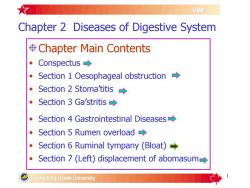
VIMChapter 2 Diseases of Digestive System$ Chapter Main ContentsConspectus+Section1Oesophageal obstructionSection 2 Stoma'titisSection 3 Ga'stritisSection4GastrointestinalDiseasesSection5RumenoverloadSection 6Ruminal tympany (Bloat)Section 7 (Left) displacement of abomasumGuangdong OceanUniversity
1 Chapter 2 Diseases of Digestive System Chapter Main Contents • Conspectus • Section 1 Oesophageal obstruction • Section 2 Stoma’titis • Section 3 Ga’stritis • Section 4 Gastrointestinal Diseases • Section 5 Rumen overload • Section 6 Ruminal tympany (Bloat) • Section 7 (Left) displacement of abomasum
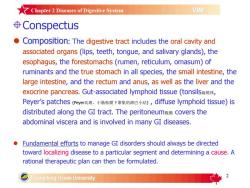
Chapter2Diseases ofDigestive SystemVIM$ConspectusComposition: The digestive tract includes the oral cavity andassociated organs (lips, teeth, tongue, and salivary glands), theesophagus, the forestomachs (rumen, reticulum, omasum) ofruminants and the true stomach in all species, the small intestine, thelarge intestine, and the rectum and anus, as well as the liver and theexocrine pancreas. Gut-associated lymphoid tissue (tonsils扁桃体,Peyer'spatches(Peyer氏斑,小肠粘膜下聚集的淋巴小结),diffuselymphoidtissue)isdistributed along the GI tract. The peritoneum腹膜 covers theabdominal viscera and is involved in many GI diseases.Fundamental efforts to manageGI disorders should always be directedtoward localizing disease to a particular segment and determining a cause.Arational therapeuticplan can then be formulated.Guangdong Ocean University
2 Conspectus The digestive tract includes the oral cavity and associated organs (lips, teeth, tongue, and salivary glands), the esophagus, the forestomachs (rumen, reticulum, omasum) of ruminants and the true stomach in all species, the small intestine, the large intestine, and the rectum and anus, as well as the liver and the exocrine pancreas. Gut-associated lymphoid tissue (tonsils扁桃体, Peyer’s patches (Peyer氏斑,小肠粘膜下聚集的淋巴小结) , diffuse lymphoid tissue) is distributed along the GI tract. The peritoneum腹膜 covers the abdominal viscera and is involved in many GI diseases. l Fundamental efforts to manage GI disorders should always be directed toward localizing disease to a particular segment and determining a cause. A rational therapeutic plan can then be formulated. Chapter 2 Diseases of Digestive System
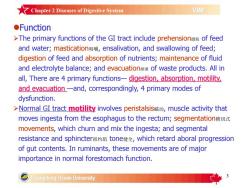
Chapter2Diseases of DigestiveSystemVIMFunction>TheprimaryfunctionsoftheGItract includeprehension摄取offeedand water;mastication咀嚼,ensalivation,and swallowing offeed;digestion of feed and absorption of nutrients; maintenance of fluidand electrolytebalance;and evacuation排泄of waste products.All inall, There are 4 primary functions- digestion, absorption, motility.and evacuationand, correspondingly, 4 primary modes ofdysfunction.>Normal GI tract motility involves peristalsis蠕动, muscle activity thatmovesingestafromtheesophagustotherectum;segmentation横切式movements, which churn and mix the ingesta; and segmentalresistanceandsphincter括约肌tone健全,whichretardaboralprogressionof gut contents. In ruminants, these movements are of majorimportanceinnormalforestomachfunction.GuangdongOceanUniversity
3 ØThe primary functions of the GI tract include prehension摄取 of feed and water; mastication咀嚼, ensalivation, and swallowing of feed; digestion of feed and absorption of nutrients; maintenance of fluid and electrolyte balance; and evacuation排泄 of waste products. All in all, There are 4 primary functions— —and, correspondingly, 4 primary modes of dysfunction. ØNormal GI tract involves peristalsis蠕动, muscle activity that moves ingesta from the esophagus to the rectum; segmentation横切式 movements, which churn and mix the ingesta; and segmental resistance and sphincter括约肌 tone健全, which retard aboral progression of gut contents. In ruminants, these movements are of major importance in normal forestomach function. Chapter 2 Diseases of Digestive System
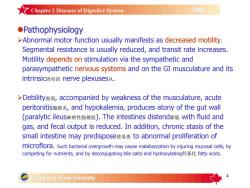
Chapter2Diseases of DigestiveSystemVIMPathophysiology>Abnormal motor function usually manifests as decreased motility.Segmental resistance is usually reduced, and transit rate increases.Motility depends on stimulation via the sympathetic andparasympathetic nervous systems and on the GI musculature and itsintrinsic固有的nerveplexuses丛,>Debility虚弱, accompanied by weakness of the musculature, acuteperitonitis腹膜炎,and hypokalemia,produces atonyof the gut wall(paralytic ileuS麻痹性肠梗阻).Theintestines distend膨胀withfluidandgas, and fecal output is reduced. In addition, chronic stasis of thesmall intestine may predispose使易患 to abnormal proliferation ofmicroflora. Such bacterial overgrowth may cause malabsorption by injuring mucosal cells, bycompeting for nutrients, and by deconjugating bile salts and hydroxylating羟基化 fatty acidsGuangdong Ocean University
4 ØAbnormal motor function usually manifests as decreased motility. Segmental resistance is usually reduced, and transit rate increases. Motility depends on stimulation via the sympathetic and parasympathetic nervous systems and on the GI musculature and its intrinsic固有的 nerve plexuses丛. ØDebility虚弱, accompanied by weakness of the musculature, acute peritonitis腹膜炎, and hypokalemia, produces atony of the gut wall (paralytic ileus麻痹性肠梗阻). The intestines distend膨胀 with fluid and gas, and fecal output is reduced. In addition, chronic stasis of the small intestine may predispose使易患 to abnormal proliferation of microflora. Such bacterial overgrowth may cause malabsorption by injuring mucosal cells, by competing for nutrients, and by deconjugating bile salts and hydroxylating羟基化 fatty acids. Chapter 2 Diseases of Digestive System
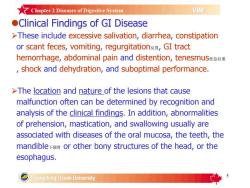
★Chapter2Diseases of DigestiveSystemVIMClinicalFindingsofGIDisease>These include excessive salivation, diarrhea,constipationor scantfeces,vomiting,regurgitation反,GItracthemorrhage, abdominal pain and distention,tenesmus里急后重,shock and dehydration, and suboptimal performance.Thelocationand natureof thelesionsthatcausemalfunction often can be determined by recognition andanalysis of the clinical findings. In addition, abnormalitiesof prehension,mastication,and swallowingusuallyareassociated with diseases ofthe oral mucosa, theteeth, themandible下领骨orotherbonystructuresofthehead,ortheesophagus.Guangdong Ocean University
5 ØThese include excessive salivation, diarrhea, constipation or scant feces, vomiting, regurgitation反胃, GI tract hemorrhage, abdominal pain and distention, tenesmus里急后重 , shock and dehydration, and suboptimal performance. ØThe location and nature of the lesions that cause malfunction often can be determined by recognition and analysis of the clinical findings. In addition, abnormalities of prehension, mastication, and swallowing usually are associated with diseases of the oral mucosa, the teeth, the mandible下颌骨 or other bony structures of the head, or the esophagus. Chapter 2 Diseases of Digestive System
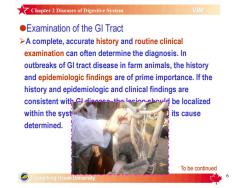
Chapter2Diseases of DigestiveSystemVIMExamination of the GI Tract>Acomplete,accuratehistoryandroutineclinicalexamination can often determine the diagnosis.Inoutbreaks of Gl tract disease in farm animals, the historyand epidemiologic findings are of prime importance.If thehistoryand epidemiologic and clinical findings aretha lacion ehould be localizedconsistent with Cl-iTitscausewithin the syst拉determined.To be continuedGuangdong Ocean University
6 ØA complete, accurate history and routine clinical examination can often determine the diagnosis. In outbreaks of GI tract disease in farm animals, the history and epidemiologic findings are of prime importance. If the history and epidemiologic and clinical findings are consistent with GI disease, the lesion should be localized within the system, and the type of lesion and its cause determined. To be continued Chapter 2 Diseases of Digestive System
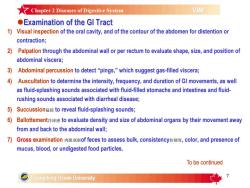
★Chapter2Diseases of Digestive SystemVIMExaminationoftheGl Tract1) Visual inspection of the oral cavity,and of thecontourof theabdomen for distention orcontraction;2)Palpation through theabdominal wall or per rectum to evaluate shape, size,and position ofabdominal viscera;3)Abdominal percussion todetect“pings,"which suggestgas-filledviscera;4)Auscultation todetermine the intensity,frequency,andduration of GI movements,as wellas fluid-splashing sounds associated with fluid-filled stomachs and intestines and fluidrushing sounds associated with diarrheal disease;5)Succussion猛摇torevealfluid-splashingsounds;6) Ballottement浮球感to evaluatedensityand sizeofabdominal organsbytheirmovementawayfrom and backto the abdominal wall;7)Grossexamination肉眼观察offecestoassessbulk,consistency软硬度,color,andpresenceofmucus,blood,orundigestedfood particles.To be continuedGuangdong Ocean University
7 1) Visual inspection of the oral cavity, and of the contour of the abdomen for distention or contraction; 2) Palpation through the abdominal wall or per rectum to evaluate shape, size, and position of abdominal viscera; 3) Abdominal percussion to detect “pings, ” which suggest gas-filled viscera; 4) Auscultation to determine the intensity, frequency, and duration of GI movements, as well as fluid-splashing sounds associated with fluid-filled stomachs and intestines and fluid- rushing sounds associated with diarrheal disease; 5) Succussion猛摇 to reveal fluid-splashing sounds; 6) Ballottement浮球感 to evaluate density and size of abdominal organs by their movement away from and back to the abdominal wall; 7) Gross examination 肉眼观察of feces to assess bulk, consistency软硬度, color, and presence of mucus, blood, or undigested food particles. To be continued Chapter 2 Diseases of Digestive System
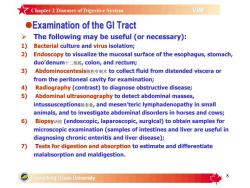
7Chapter2 Diseases of Digestive SystemVIMExaminationoftheGlTractThe following may be useful (or necessary):Bacterial culture and virus isolation;2)Endoscopyto visualizethemucosal surface oftheesophagus,stomachduo'denum+二指肠,colon,andrectum;3)Abdominocentesis腹腔穿刺术tocollectfluidfromdistendedvisceraorfrom the peritoneal cavity for examination;4)Radiography (contrast)to diagnose obstructive disease;5)Abdominal ultrasonography to detect abdominal masses,intussusceptions肠套叠,and mesen'teric lymphadenopathy in smallanimals, and to investigate abdominal disorders in horses and cows;6)Biopsy活检(endoscopic,laparoscopic,surgical)toobtainsamplesformicroscopicexamination(samples of intestines and liver are useful indiagnosing chronic enteritis and liver disease);7Testsfor digestionandabsorptiontoestimate and differentiatemalabsorption and maldigestion.Guangdong Ocean University
8 Ø The following may be useful (or necessary): 1) Bacterial culture and virus isolation; 2) Endoscopy to visualize the mucosal surface of the esophagus, stomach, duo’denum十二指肠, colon, and rectum; 3) Abdominocentesis腹腔穿刺术 to collect fluid from distended viscera or from the peritoneal cavity for examination; 4) Radiography (contrast) to diagnose obstructive disease; 5) Abdominal ultrasonography to detect abdominal masses, intussusceptions肠套叠, and mesen’teric lymphadenopathy in small animals, and to investigate abdominal disorders in horses and cows; 6) Biopsy活检 (endoscopic, laparoscopic, surgical) to obtain samples for microscopic examination (samples of intestines and liver are useful in diagnosing chronic enteritis and liver disease); 7) Tests for digestion and absorption to estimate and differentiate malabsorption and maldigestion. Chapter 2 Diseases of Digestive System
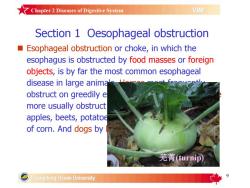
ZChapter2Diseases of Digestive SystemVIMSection 1 Oesophageal obstructionEsophageal obstructionorchoke,inwhichtheesophagus is obstructed by food masses or foreignobjects,isbyfarthemostcommonesophagealdisease in large animalobstruct on greedily emore usually obstructapples,beets,potatoeof corn.And dogs by芜菁(turnip)GuangdongOcean University
9 Section 1 Oesophageal obstruction n Esophageal obstruction or choke, in which the esophagus is obstructed by food masses or foreign objects, is by far the most common esophageal disease in large animals. Horses most frequently obstruct on greedily eaten dried grains or hay. Cattle more usually obstruct on a single solid object, eg, apples, beets, potatoes, turnips, corn stalks, or ears of corn. And dogs by bones (when dog is scared). 芜菁(turnip) Chapter 2 Diseases of Digestive System
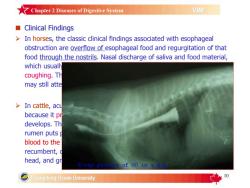
7 Chapter2 Diseases of Digestive SystemVIMClinical Findings In horses, the classic clinical findings associated with esophagealobstruction are overflow of esophageal food and regurgitation of thatfood through the nostrils. Nasal discharge of saliva and food material,which usuallycoughing. Thmay still atte> In cattle,acubecause it prdevelops. Thrumen puts blood to therecumbent, head, and grof00inGuangdong Ocean University
10 Ø In horses, the classic clinical findings associated with esophageal obstruction are overflow of esophageal food and regurgitation of that food through the nostrils. Nasal discharge of saliva and food material, which usually also spills from the pharynx into the airway, induces coughing. The horse is anxious and may stretch and arch its neck but may still attempt to continue to either eat or drink. Ø In cattle, acute and complete esophageal obstruction is an emergency because it prohibits the eructation of ruminal gases, and free-gas bloat develops. This in turn may result in asphyxia(窒息) as the expanding rumen puts pressure on the diaphragm(膜膈) and reduces return of blood to the heart. The cow may be bloated and in distress or recumbent, or there may be protrusion of the tongue, extension of the head, and grinding of the teeth with excess salivation. Chapter 2 Diseases of Digestive System
按次数下载不扣除下载券;
注册用户24小时内重复下载只扣除一次;
顺序:VIP每日次数-->可用次数-->下载券;
- 广东海洋大学:《兽医内科学》课程教学课件(讲稿)Chapter 1 Introduction to VIM.pdf
- 广东海洋大学:《兽医内科学》课程教学资源(教案讲义,共六章,任课教师:陈进军、康丹菊).doc
- 广东海洋大学:《兽医内科学》实验课程教学大纲 Veterinary Internal Medicine.doc
- 广东海洋大学:《兽医内科学》课程实验指导(讲义)实验四 血液丙酮酸的测定.doc
- 广东海洋大学:《兽医内科学》课程实验指导(讲义)实验三 血清谷丙、谷草转氨酶活力测定(赖氏法).doc
- 广东海洋大学:《兽医内科学》课程实验指导(讲义)实验二 氢氰酸的定性与定量检验.doc
- 广东海洋大学:《兽医内科学》课程实验指导(讲义)实验一 血清总钙含量的测定.doc
- 塔里木大学:《兽医临床诊断学》课程实验课教案.docx
- 塔里木大学:《兽医临床诊断学》课程实验教学大纲.pdf
- 塔里木大学:《兽医临床诊断学》课程理论课教案.docx
- 塔里木大学:《兽医临床诊断学》课程教学大纲 Veterinary Clinical Diagnostics.pdf
- 《兽医外科学》课程教学课件(PPT讲稿)第十五章 小动物牙病.ppt
- 《兽医外科学》课程教学课件(PPT讲稿)第十四章 四肢疾病.ppt
- 《兽医外科学》课程教学课件(PPT讲稿)第十三章 跛行诊断.ppt
- 《兽医外科学》课程教学课件(PPT讲稿)第十二章 泌尿生殖系统疾病.ppt
- 《兽医外科学》课程教学课件(PPT讲稿)第十一章 直肠及肛门疾病.ppt
- 《兽医外科学》课程教学课件(PPT讲稿)第七章 头部疾病.ppt
- 《兽医外科学》课程教学课件(PPT讲稿)第八章 枕、颈部疾病.ppt
- 《兽医外科学》课程教学课件(PPT讲稿)第九章 胸腹壁及脊柱疾病.ppt
- 《兽医外科学》课程教学课件(PPT讲稿)第十章 疝.ppt
- 广东海洋大学:《兽医内科学》课程教学课件(讲稿)Chapter 3 Diseases of Respiratory System.pdf
- 广东海洋大学:《兽医内科学》课程教学课件(讲稿)Chapter 4 Diseases of cardiovascular system.pdf
- 广东海洋大学:《兽医内科学》课程教学课件(讲稿)Chapter 5 Diseases of Urinary system.pdf
- 广东海洋大学:《兽医内科学》课程教学课件(讲稿)Chapter 6 Diseases of the nervous system.pdf
- 西昌学院:《动物遗传学》实验课程教学大纲.docx
- 西昌学院:《家畜解剖学》实验课程教学指导(共十八个实验).doc
- 龙岩学院:《预防兽医学》实验课程教学大纲.docx
- 龙岩学院:《基础兽医学》实验课程教学大纲.docx
- 龙岩学院:《临床兽医学》实验课程教学大纲.docx
- 南京农业大学:《兽医内科学》实验课程教学大纲(强化).doc
- 南京农业大学:《兽医内科学》实验课程教学大纲(动医).doc
- 南京农业大学:《兽医内科学》实验课程教学大纲.doc
- 南京农业大学:《兽医临床诊断学》实验课程教学大纲(动医、实验).doc
- 南京农业大学:《动物解剖学》课程II教学大纲(动医).pdf
- 南京农业大学:《动物解剖学》课程II教学大纲(动物实验).pdf
- 南京农业大学:《宠物解剖学》课程教学大纲.pdf
- 南京农业大学:《中兽医学》实验课程教学大纲.pdf
- 南京农业大学:《兽医药理学》实验课程教学大纲.pdf
- 南京农业大学:《兽医药代动力学》实验课程教学大纲.pdf
- 南京农业大学:《药物化学》实验课程教学大纲.pdf
